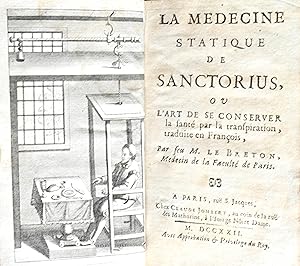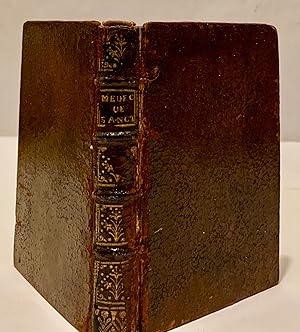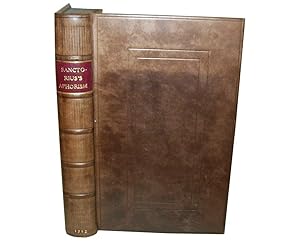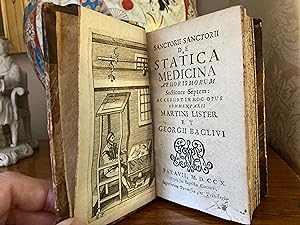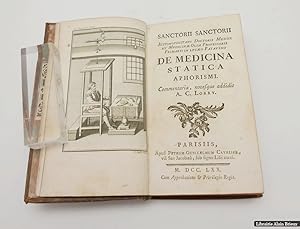sanctorius santorio santorio (9 resultados)
ComentariosFiltros de búsqueda
Tipo de artículo
- Todos los tipos de productos
- Libros (9)
- Revistas y publicaciones (No hay ningún otro resultado que coincida con este filtro.)
- Cómics (No hay ningún otro resultado que coincida con este filtro.)
- Partituras (No hay ningún otro resultado que coincida con este filtro.)
- Arte, grabados y pósters (No hay ningún otro resultado que coincida con este filtro.)
- Fotografías (No hay ningún otro resultado que coincida con este filtro.)
- Mapas (No hay ningún otro resultado que coincida con este filtro.)
- Manuscritos y coleccionismo de papel (No hay ningún otro resultado que coincida con este filtro.)
Condición
- Todos los libros
- Nuevos (No hay ningún otro resultado que coincida con este filtro.)
- Antiguos o usados (9)
Encuadernación
- Todas
- Tapa dura (6)
- Tapa blanda (No hay ningún otro resultado que coincida con este filtro.)
Más atributos
- Primera edición (2)
- Firmado (No hay ningún otro resultado que coincida con este filtro.)
- Sobrecubierta (No hay ningún otro resultado que coincida con este filtro.)
- Con imágenes (6)
- No impresión bajo demanda (9)
Idioma (2)
Precio
- Cualquier precio
- Menos de EUR 20 (No hay ningún otro resultado que coincida con este filtro.)
- EUR 20 a EUR 45 (No hay ningún otro resultado que coincida con este filtro.)
- Más de EUR 45
Gastos de envío gratis
Ubicación del vendedor
Valoración de los vendedores
-
De Medicina Statica Aphorismi. Commentaria, Notasque Addidit A. C. Lorry
Publicado por Apud Vincentium Ursinum Expensis Josephi De Lieto, Napoli (Neapoli), 1784
Librería: The Chatham Bookseller, Madison, NJ, Estados Unidos de America
EUR 113,43
Convertir monedaGastos de envío gratisCantidad disponible: 1 disponibles
Añadir al carritoVellum. Condición: Good+. No Jacket. Title page, 7 prelims, 1-279 [i.e., 379] pp, 1p.: Explanatio Tabulae. Vellum covered boards, remnants of gilt title on spine. Marbled page edges. Binding is very secure, front board is canted. vellum toned and stained at extremities. Pages show ususal toning and spotting but otherwise clean and legible. Title page has closed tear. Top corners of last 40 pages crinkled and rubbed, not affecting text. Mylar cover. Santorio (1561-1636) was the founder of the physiology of metabolism and experimental physiology. He introduced into physiology exact methods of measurement, pulse counting, temperature determination and weighing. Garrison-Morton 573 (first edition). Commentary by French doctor Anne Charles Lorry. In Latin. Size: 4 1/4" x 7".
-
La médecine statique de Sanctorius, ou l'Art de se conserver par la transpiration, traduite en françois par feu M. Le Breton.
Publicado por Paris, C. Jombert, 1722, 1722
Idioma: Francés
Librería: Jean-Pierre AUBERT, Quiberon, Francia
EUR 270,00
Convertir monedaEUR 35,00 Gastos de envíoCantidad disponible: 1 disponibles
Añadir al carritoCouverture rigide. Condición: Satisfaisant. 1 vol. in-16 (13 x 8 cm), X, 219 (chiffré par erreur 119), (5) pp., 1 planche en frontispice, pleine basane de l'époque, dos à nerfs orné, super ex-libris du chirurgien Marc-Antoine Petit avec l'inscription "Marco Antonio Petit et Amicis" frappée au plat supérieur et entourée d'une guirlande dorée, tranches rouges, 1 mors en partie fendu, coiffes usées, petites taches sur le plat supérieur, frontispice présentant une mouillure angulaire interessant environ le 1/4 de la planche (mais ne touchant néanmoins pas les éléments importants de la scène représentée), état satisfaisant. Cet ouvrage avait paru en latin en 1614 sous le titre "Ars de statica medicina, sectionibus aphorismorum septem comprehensa". Il fut traduit en français en 1695 sous le titre "Science de la transpiration ou médecine statique". Cette nouvelle édition, sous un titre différent, est illustrée d'un joli frontispice, souvent reproduit. Sanctorius (Santorio) (1561-1636) exerça à Venise et à Padoue (où il fut premier professeur de médecine théorique. Cet ouvrage, novateur et devenu célèbre, est représenté par une série d'aphorismes (501 aphorismes réparties en sept sections), résultat de très longues et minutieuses expériences que Sanctorius fit sur lui- même afin de comparer le poids de son corps au poids des aliments ingérés et à celui des excrétions. Sanctorius utilisa, pour la première fois en médecine, un ensemble d'instruments de mesure (balance, thermomètre à air, pulsilogue), inaugurant ainsi la naissance de la physiologie expérimentale moderne. REFERENCES : One hundred books famous in medicine, 25 (pp. 96-98) et Garrison & Morton, 573 (pour l'édition originale latine); L.K.Altman The story of self-experimentation in medicine, pp . 22-23; Castiglioni, Histoire de la médecine, pp. 432-434; Dorbon, Bibliotheca Esoterica, 4835;
-
Medicina Statica: Being the Aphorisms of Sanctorius, Translated into English with large Explanations. Wherein is given A Mechanical Account of the Animal Oeconomy, and of the Efficacy of the Non-Naturals, either in bringing about or removing its Disorders: Also with an Introduction Concerning Mechanical Knowledge, and the Grounds of Certainty in Physic.
Publicado por William Newton, 1718., London:, 1718
Librería: Jeff Weber Rare Books, Neuchatel, NEUCH, Suiza
Original o primera edición
EUR 245,02
Convertir monedaEUR 25,00 Gastos de envíoCantidad disponible: 1 disponibles
Añadir al carrito8vo. (190 x 117 mm) lvi, 312 pp. Engraved frontispiece, 1 folding plate. Signature P mis-bound (P1-2 after P3-4), light toning throughout. Bound in full modern calf to period style, raised bands and gilt-stamped decoration on spine, black leather gilt-stamped spine label. Fine. Second edition. "The frontispiece of [this edition] shows Santorio's famous balance seat where he spent much of his time eating, working, and sleeping. Over a period of 30 years he weighed his dietary intake and bodily excretions and determined that the amount of the visible excreta was less than what he ate and drank. He concluded that a substantial portion of the weight of his food intake was lost from the body through his skin as 'insensible perspiration.'" âÂÂ" University of Virginia, Claude Moore Health Sciences Library. Issued along with Medico-physical Essays in 1720, this popular text went through many editions, even as late as the early 19th century. Sanctorius (1561-1636) was the founder of the physiology of metabolism. He introduced into physiology exact methods of measurement, pulse counting, temperature determination and weighing. Here Quincy translates into English topics that he feels are the most difficult. Included are aphorisms on insensible perspiration (including plague), air and water, meats and drink. sleep and watching, exercise and rest, venery, and affections of the mind. "John Quincy, medical writer, was apprenticed to an apothecary, and afterward practiced medicine as an apothecary in London. He was a dissenter and a Whig, a friend of Dr. Richard Mead, and an enemy of Dr. John Woodward. He studied mathematics and the philosophy of Sir Isaac Newton, and received the degree of M.D. from the University of Edinburgh for his Medicina Statica Britannica (1712), a translation of the Aphorisms of Sanctorius, of which a second edition appeared in 1720. In 1720 . . . he published a collection of Medico-physical Essays on ague, feberes, gout, leprosy, king's evil, and other diseases, which shows that he knew little of clinical medicine, and was only skilful in the arrangement of drugs in prescriptions. He considered dried millipedes good for tuberculous lymphatic glands, but esteemed the royal touch a method 'that can take place only on a deluded imagination,' and 'justly banished with the superstition and bigotry that introduced it.'" - [DNB]. References: BM Readex, Vol. 20, p. 1178 (1st ed.); DNB, Vol. XVI, pp. 555-6; Garrison and Morton 573 (Sanctorio); Osler 3915; Waller 7713; Wellcome III, p. 458 (1720 ed.).
-
La Medecine Statique De Sanctorius, ou L'Art De Se Conserver la sante par la transpiration, traduite en Francois; Par sue M. Le Breton, Medecin de la Faculte de Paris
Publicado por Claude Jombert, Paris, 1722
Librería: Royoung Bookseller, Inc. ABAA, Ardsley, NY, Estados Unidos de America
EUR 353,91
Convertir monedaEUR 7,05 Gastos de envíoCantidad disponible: 1 disponibles
Añadir al carritoleather_bound. 119 pages [*7,A8-O8]. 13 1/2 x 9 cm. Engraved frontispiece. Italian physiologist, physician and professor, Santorio initiated his medical practice in Venice, 1599, where he became part of a learned circle that included Galileo. He invented a device he called the "pulsilogium" for measuring the pulse which was the first machine sytstem in medical history. His most famous experiments involve the study of bodily weight. This work made him famous throughout Europe. He was the first to apply a numerical scale to the thermoscope, which later evolved into the thermometer [see: PRINTING AND THE MIND OF MAN 182]. Raised bands, spine panels decorated in gilt, red leather spine label printed in gilt, marbled boards, bookplate, backstrip worn head and foot, front cover joint cracked but firm. Contemporary full brown calf. Very good.
-
Medicina Statica: Being the Aphorisms of Sanctorius, Translated Into English with Large Explanations
Publicado por William Newton, London, 1712
Original o primera edición
EUR 361,35
Convertir monedaEUR 29,24 Gastos de envíoCantidad disponible: 1 disponibles
Añadir al carritoFull Calf. Condición: Good. First Edition. lvi, 312pp, rebound in modern calf, raised bands, spine in six panels, morocco title label to second panel, date in gilt to foot of spine, covers bordered with single fillet, with central panel all in blind. Spine slightly faded, covers unevenly faded, slightly rubbed. Internally lightly browned and slightly foxed throughout, pages of signature X have been repeated, previous owners name to title. Engraved frontispiece and one folding plate. The first edition of Quincy's translation. ESTC T100344, Wellcome IV:458 Size: 8vo.
-
De Statica Medicina Aphorismorum Sectiones Septem: ac Sedunt in Hoc Opus Commentarii Martini Lister et Georgii Baglivi.
Publicado por Patavii: Typis Jo. Baptistae Conzatti, 1710
Librería: Colin Page Books, Storrington, Reino Unido
EUR 192,72
Convertir monedaEUR 46,78 Gastos de envíoCantidad disponible: 1 disponibles
Añadir al carritoThe third printing with Lister's commentary, the work having been originally published in 1614. With a new dedication dated 1710. Duodecimo (14 x 8.5cm). ' In 1614 he published De Statica Medicina, a short work on the variation of weigh experienced by the human body as a result of ingestion and excretion. Filled with incisive and elliptic aphorisms, it dazzled his contemporaries and made him famous'- DSB. 'Ce livre est tres curieux et tres interessant'- Ladvocat. pp. [20],266. With an engraved frontispiece. A few margins in the prelims with very neat marginal repairs (with loss of no more than three letters), a few minor stains, slight loss to lower-edge margin title page. Otherwise an excellent copy in contemporary half calf, rubbed, but quite sound. Vg. [Keynes (Lister) 37; DSB XII, 101; Blake 401; Ladvocat III, 368; Garrison & Morton 573; Wellcome V, 22; Olschki Choix 9484; Osler 3914].
-
EUR 250,00
Convertir monedaEUR 45,00 Gastos de envíoCantidad disponible: 1 disponibles
Añadir al carritoCouverture rigide. Condición: Bon. front., [4]-XXXVI-395 pp. Paris, Pierre-Guillaume Cavelier, 1770, in-8, front, [4]-XXXVI-395 pp, Basane marbrée de l'époque, dos à nerfs et fleuronné, pièce de titre fauvre, tranches rouges, Édition parisienne de la Medicina statica du médecin padouan Santorio (1561-1636), publiée pour la première fois à Venise en 1614 et annotée ici par le médecin français Anne-Charles Lorry (1726-1783). L'auteur y présente, sous la forme d'aphorismes, les résultats de ses expériences sur la pesée. Santorio est considéré comme l'un des fondateurs de la physiologie expérimentale. Il acquit une réputation méritée pour ses recherches sur la transpiration, au service desquelles il mit au point une chaise-balance, représentée au frontispice de la présente édition ; cet appareil, suspendu au plafond, permettait de contrôler les pertes corporelles par le biais d'une pesée systématique. In fine, il servait aux préoccupations diététiques de l'auteur, en permettant de déterminer la quantité saine de nourriture à ingérer au cours d'un repas. Étiquette du XVIIIe siècle de la bibliothèque du médecin Moublet-gras, docteur en médecine de l'Université de Montpellier et médecin à Tarascon en Provence. Ex-libris de Jean Rouché. Usures et épidermures : bonne tenue de la reliure, néanmoins, et bel état intérieur. Blake, 401.
-
De Statica Medicina Aphorismorum sectiones septem: cum commentario Martini Lister.
Publicado por Londini: Impensis Sam. Smith & Ben. Walford? 1701., 1701
Librería: Nigel Phillips ABA ILAB, Chilbolton, Reino Unido
EUR 869,05
Convertir monedaEUR 52,62 Gastos de envíoCantidad disponible: 1 disponibles
Añadir al carrito12mo, pp. (xxii), XII, 213, engraved frontispiece showing Santorio in his weighing chair. Title within double ruled border. Modern calf antique. First edition to be edited with a commentary by Dr. Martin Lister. With this book Santorio founded the physiology of metabolism, and introduced quantitative experimentation into biological science. He introduced exact methods of measurement, with himself as the subject. Using the balance as an instrument of weight control, the pulse-clock and the thermometer, he measured pulse-rate, respiration, body temperature and daily variations in weight relative to ingestion and excretion. Throughout the seventeenth and eighteenth centuries Santorio was regarded, with Harvey, as one of the greatest figures in the history of physiology. See G&M 573 (first edition of 1614); also Foster, Lectures on the history of physiology, pp. 145?147.
-
De statica medicina aphorismorum . commentarii M. Lister et G. Baglivi.
Año de publicación: 1710
Librería: Antiq. F.-D. Söhn - Medicusbooks.Com, Marburg, Alemania
EUR 550,00
Convertir monedaEUR 36,45 Gastos de envíoCantidad disponible: 1 disponibles
Añadir al carritoPatavii, typis J.B. Conzatti, 1710, Kl.8°, (20), 266 pp., mit einer Kupfertafel, die Santorio mit Mahlzeit im "Wiegestuhl" sitzend zeigt, Pergament der Zeit. Das klassische Werk der Stoffwechselforschung! Durch Einführung von Maß und Zahl in die medizinische Forschung ist Santorio zum Begründer der Biometrie geworden. Seine Werkzeuge waren das Thermometer, das Hygrometer, der Pulsmesser und vor allem die Waage. Santorio kontrollierte sein Gewicht auf einer Waage. Mit eisener Konsequenz wog er fast über 30 Jahre die zugeführte Nahrung u. die abgehenden Exkremente, um das Stoffwechselgeschehen messend zu erfassen. Die Differenz seiner Messungen führte er auf die "perspiratio insensibilis", die Ausscheidungen durch Mund und Haut zurück. Das in aphoristischer Form geschriebene Werk liegt hier mit den bekannten Kommentaren von Lister u. Baglivi vor. Santorios Buch war für ein ganzes Säkulum das am meisten verbreitete und gelobte medizinische Buch. Es erlebte 28 latein. Auflagen, und noch Boerhaave lobte begeistert: "Kein medizin. Werk ist mit socher Perfektion geschrieben." Mit Galilei, seinem Freund, war Santorio als Profesor an der Universität Padua tätig. Garrison & Morton No. 573: Sanctorius was the founder of the physiology of metabolism. He introduced into physiology exact methods of measurement, pulse counting, temperature determination, and weighing. English translations 1676, 1712, 1742.



